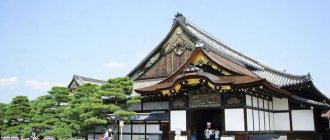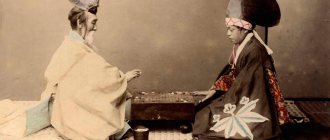HomeFor tourists Where to go on vacation
Japanese hotels - ryokans - are one of the most authentic attributes of the country. No "stars", no doormen and revolving glass doors at the entrance. The rooms have a minimum of furniture. Instead of the usual hotel robe - a yukata. Instead of a bed, there is a futon on the floor, or rather, on a tatami - a thin mat made of rice straw. They walk around the room in slippers, which must be taken off every time they step on the tatami.
People go to ryokans not only to just spend the night.
There you can take a break from the bustle of everyday life and the rhythm of the metropolis, connect with silence, nature and yourself, which is why there is no WI-Fi in the rooms. Keep in mind that not every Japanese can get into a ryokan, not to mention foreigners: not only do ryokans sometimes cost several times more than regular hotels, but you also need to book accommodation here several months in advance.
Ryokan - a temple of Japanese hospitality
In addition to Western-style hotels, there are ryokans in Japan - hotels in which everything is furnished in the spirit of traditional Japanese culture.
Everything here is subject to seasonality; The interiors of the washitsu rooms are made in the Japanese style with all its essential elements: tatami mats, movable shoji partitions, a tokonoma niche in which a kakemono wall scroll hangs and ikebana (flower arrangement) is displayed. People sleep in such rooms not on beds, but on traditional sleeping mattresses - futons. At the ryokan you can take a Japanese o-furo bath and immerse yourself in the tranquil atmosphere of a Japanese traditional home. Such famous actors as Tommy Lee Jones and Tom Cruise have openly admitted their love for Japanese ryokans.
Typically, a ryokan has at least five guest rooms, but there can be many more. Some establishments have more than eighty rooms for guests. According to 2014 statistics, there are about forty-three thousand ryokans throughout Japan, the menus of which, as well as the rules for serving guests, vary depending on the region. The hotel manager and okami hostess (who designs the rooms and the building, as well as the ceremonial side of the service) go to great lengths to ensure that their establishment is unlike any other, so you're unlikely to find two identical ryokan.
How much does it cost to stay in a ryokan?
Sometimes people are surprised by the prices in ryokans, which at first glance seem higher than in hotels. And you should keep in mind that ryokan prices are often quoted per person rather than per room. But before you conclude that ryokan prices are overpriced, remember that the price of a ryokan usually includes one or two meals, and the meals can often be elaborate kaiseki dishes. Once you find out what two good meals at restaurants will cost, the cost of a ryokan can often be quite reasonable. Here's how we break down ryokans by price:
Ryokan in Tokyo. We are preparing for the 2020 Summer Olympics.
Budget: less than 10,000 yen per person Medium budget: 10,000 to 20,000 yen per person VIP: more than 20,000 yen per person
Capsule number.
Ryokan: the ABC of a guest
The ryokan has a special employee, nakai, who is both a personal servant and your advisor on all everyday matters during your stay in the ryokan. She will tell you about the customs of the ryokan, will take care of your comfort and convenience with truly Japanese hospitality, and will lay out your futon at night and remove it in the morning.
Just as is customary in Japanese homes, it is customary to take off your shoes and put on slippers when entering a ryokan. If guests need to go outside for a short time, they can use sandals or traditional geta shoes, which can be borrowed from the ryokan.
Unlike hotels, the ryokan does not have a fitness room or swimming pool. Most often, in addition to a separate private bathroom, visitors can also use public baths (separate for men and women) and rotemburo - outdoor baths. Some ryokan have karaoke and table tennis rooms for guests.
Rothemburo
After a leisurely swim in the o-furo, the guest changes into a comfortable yukata robe prepared in advance for him, which does not restrict movement, which is also used as pajamas. After changing clothes, it is not at all necessary to stay in the room, because in a ryokan, yukata is a common form of clothing for all vacationers. And if the ryokan is located in some town with thermal springs, then in the hotel yukata you can safely walk along the street.
Guests often spend one night at the ryokan, receiving two meals a day. You can have dinner either in the dining room or in your room. If a guest has ordered dinner to the room, the nakai servant brings the order to him and makes sure that everything is served on the table in a timely manner. She also takes orders for alcoholic drinks. A special pleasure is to order dishes made from seasonal and locally produced products.
Dinner served in the room. In the background is a tokonoma niche with a kakemono wall scroll and a flower arrangement (ikebana).
As a rule, in modern Japan, guests do not pay tips in either hotels or ryokans, but in some places the custom of leaving a monetary gift (tip) to the nakai is still preserved as a sign of gratitude. Unlike hotels, it is almost impossible to get into a ryokan for an overnight stay without making a reservation in advance, so it is important to make a reservation online or by phone in advance.
How to live in a ryokan?
Staying in a ryokan is a little different from staying in a hotel.
You first take off your shoes in the vestibule (usually where you rise from ground level into the vestibule). Next, you will be shown to your room, where a cup of tea and traditional sweets or crackers will be waiting for you. If it is already evening, you will change into the yukata (light clothing) provided by the ryokan. In an expensive room, you will have dinner served in your room, otherwise you will dine in the common room with other guests or in the restaurant. After dinner, you will take a bath in either your own or a shared bath. While you bathe, the maid will lay out futons for you.
Of course, many cheaper, more modern places may skip some or all of these steps, and your stay will be much like staying in a hotel - the only difference will be futons and tatami mats instead of beds and carpets.
Feel the harmony in everything: in architecture, dishes, furniture
Visiting a ryokan is an excellent opportunity to get to know Japanese architecture better, as well as a chance to use antique dishes and household utensils, as some establishments are already a hundred or even two hundred years old. And such places are not uncommon.
The Keiunkan ryokan in Yamanashi Prefecture was founded in 705. This hotel is listed in the Guinness Book of Records as the oldest hotel currently operating in the world. The Hoshi ryokan (link in English and Japanese) in Ishikawa Prefecture has a slightly shorter history - it was founded three years later, in 718. Three of the most renowned ryokans in Kyoto for their fine cuisine: the nearing 300-year-old Tawaraya, where Steve Jobs always stayed; famous for the high quality of the tea ceremony and kaiseki cuisine "Sumiya" and the favorite place to stay for members of the imperial family and famous writers "Hiiragiya".
Amanemu
Amanemu Resort is located in Mie Prefecture and offers beautiful views of Ago Bay. It features 24 spacious suites and four two-bedroom villas with minimalist interiors filled with neutral tones and wood. All rooms come with deep soaking tubs, and villas have the added luxury of a private onsen.
To fill your free time, you can ride a bike, lie on a sun lounger by the pool or go to the spa.
The public area includes two large hot spring pools. Here you can spend the whole day relaxing in the mineral-rich waters or soaking up the sun. Just don't miss the free afternoon tea in the lounge and dinner in the restaurant.
Transformation from ryokan to RYOKAN – consistently high quality when changing concept
Hot Springs in Winter - Ginzan Onsen, Yamagata Prefecture
Recently, the number of foreign tourists has increased, and ryokans have adopted a new format - overnight stays with one meal (bed and breakfast). Some hotels provide guests with handwritten maps with information about nearby stores where you can buy food and essentials, such as the popular Tokyo ryokan Sawanoya (link in English).
According to a survey of foreigners who visited Japan, among those who spent the night in a ryokan for the first time, the most common reason for spending the night in a ryokan was an interest in Japanese architecture and interior design in the washitsu style (63.8%). Among those who stayed in a ryokan five or more times, the reason was the desire to take a dip in an onsen hot spring (78.2%). Other features of a ryokan that are attractive to foreigners are “harmoniously arranged space” (65.8%), “calm, carefree relaxation” (60.3%), “Japanese cuisine” (59%). It turned out that the problem with language can be solved with the help of gestures, pictures, dictionaries and individual words. There is a special community that helps support foreign ryokan guests, it is called the Japanese Inn Group. There are other similar groups.
At the same time, in order to preserve the original Japanese cultural characteristics, ryokans are looking for ways to adapt to the diversity of the modern world. Ryokans are a good way to get to know Japan better and feel it. Next time, be sure to try staying in a ryokan for a worry-free getaway and enjoy true Japanese hospitality.
Recommended links (in English):
Yado net Japanese Guest Houses Japan Hotel & Ryokan Search
Banner photo: Ishikawa Prefecture, Wakura Onsen, Kagaya Ryokan. Nakai servants waiting for guests to leave
How many nights should you stay at the ryokan?
Staying in a ryokan is a little more formal and sophisticated than staying in a hotel. It's a little like staying at the home of a very kind friend. But make no mistake: you should definitely try staying at a ryokan. This is a uniquely Japanese experience. And if you think about it, this is a very rare experience because traditional culture in Asia is disappearing. Apart from yurts in Mongolia and losmens in Indonesia, there really are no traditional dwellings left - only standard hotels, which are the same all over the world.
In this way, ryokans are truly special.
The cheapest type of housing in Indonesia and Bali is losmen . Most often these are simple furnished rooms without air conditioning. Breakfast is included in the price. A room in losmen cannot be booked in advance.
I usually recommend that people stay in ryokans for one or two nights at the beginning of their stay in Kyoto and then move to a hotel to enjoy the freedom and ease of a hotel stay.
Categories: Summer Olympics 2020
Category: Life of ordinary Japanese
Category: The most beautiful Japanese cities
Views: 4,296
Share link:
- Tweet
- Share posts on Tumblr
- Telegram
- More
- by email
- Seal
Western style hotels in Japan
Western-style hotels are available in all Japanese cities , and in the main cities of the country, hotels of famous international hotel chains are widely represented. The staff at these hotels speak English. At the height of the tourist season, it is better to take care of booking a hotel in advance.
Most Western-style hotels provide the same range of services as other hotels anywhere in the world, including heating, television, air conditioning, swimming pool, shopping and health centers. An additional service of providing an interpreter is possible.
The estimated cost of a room with all amenities in first-class hotels in Tokyo ranges from 15,000 to 30,000 yen for a single room, and from 25,000 to 63,000 yen for a double room.
Ryokan Kurashiki
The ryokan is located in Bikan, the historical part of Kurashiki City. It was opened in 1957. Previously, this ryokan had only 5 rooms, but this year they added 3 more. The new rooms have a view of the canal and also receive a lot of natural sunlight, so they are more popular. However, if you want to stay where Sophia Loren once stayed, then choose one of the original rooms, in particular the Okuzashiki Suite.
After you've explored the Bikan area, be sure to rest and relax at the onsen, which can be booked free of charge for private one-hour sessions. And after that you can go for a gourmet dinner at Kaiseki. Here you will be served a bowl of rice with aromatic broth and yellow leeks. And in the morning, for breakfast in the dining room overlooking the quiet garden, you will be served grilled butterfly fish.
Minshuku Guesthouses
Another great way to save costs while traveling in Japan , which also gives you a great chance to experience the everyday life of the country, is “ minshuku ”. The Japanese equivalent of a guest house is usually a family business based on renting out part of the living space. You can rent accommodation in resorts and popular holiday destinations at fairly reasonable prices.
Since minshuku are mainly home-based guesthouses, they offer a smaller range of services than in specialized hotels.
average cost of living in minshuku
Other types of overnight accommodation in Japan, particularly shukubo
Stopping overnight at Buddhist temples is a more exotic way to spend the night. Some temples allow guests to join in za-zen meditation, while others simply rent out rooms for a fee. If you are close to the philosophy of Zen Buddhism, if you want to get the most out of your trip to the land of sunrise, you should try spending the night in Shukubo. This is a “hotel” at a Buddhist monastery or Shinto shrine, elegant and ascetic at the same time. The food in Shukubo is vegetarian, at 9 pm everyone goes to bed, and the morning begins with joint meditation.
There are about 320 youth hostels in Japan, providing simple but neat rooms at very low prices. Some of them are open to everyone, others are not so accessible, as membership in the Japan Youth Hostels, Inc., or the Youth Hostel Federation is required. In principle, you can apply for membership in the Federation of Youth Hotels in your country or at the Tokyo headquarters of the above organization.
There are no age restrictions in youth hotels. At the same time, compared to other types of places of residence, there are many more different regulations and rules. The cost of living in youth hotels in Japan is about 3,000 yen per person per day, without meals.









